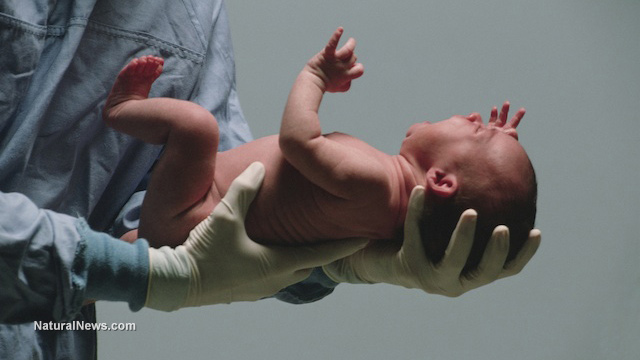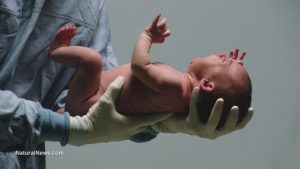
Craniosynostosis – causes, side effects and treatments at NaturalPedia.com
Saturday, February 24, 2018 by Zoey Sky
http://www.naturalpedia.com/craniosynostosis-causes-side-effects-and-treatments-at-naturalpedia-com.html

Craniosynostosis is a birth defect where the bones in a baby’s skull are joined together prematurely. As the baby’s brain grows, the skull may become more misshapen when the cranial sutures or the fibrous joints close before the brain is fully grown. It is not uncommon for a single suture to close.
Normally, a baby’s skull expands uniformly as the brain grows. But the premature closure of a single suture inhibits growth in that part of the skull. This then leads to growth in other parts of the skull where the sutures are still open. The growth in other parts of the skull results in malformation, but this doesn’t mean the brain can’t expand to a normal volume.
The types of craniosynostosis depend on what sutures join together prematurely:
- Sagittal synostosis — Causes scaphocephaly, where the head will grow long and narrow. This is the most common type of craniosynostosis.
- Coronal synostosis — Causes anterior plagiocephaly, where the baby may have a flattened forehead on the side of the skull that closed early. The baby’s eye socket on the same side might be raised up and their nose could be pulled toward that side. This is the second most common type of craniosynostosis.
- Bicoronal synostosis — Causes brachycephaly, and the baby’s head will grow broad and short.
- Lambdoid synostosis — Causes posterior plagiocephaly, and the baby’s head may be flattened on the back side. This is one of the rarest types of craniosynostosis.
- Metopic synostosis — Causes trigonocephaly, where the top of the baby’s head shape may look triangular, or narrow in the front and broad in the back. This is another rare type of craniosynostosis.

Known side effects of craniosynostosis
Some of the known side effects of craniosynostosis include:
- Absence of fontanelle in a newborn baby
- The baby’s head remains the same size as the baby grows
- Visible head deformity
Some risk factors that increase the chance of having a baby with craniosynostosis include:
- Certain medications — Women who take fertility medication called clomiphene citrate, prior to or early in pregnancy have a higher chance of giving birth to a baby with craniosynostosis.
- Maternal thyroid disease — Women with thyroid disease or those who are treated for thyroid disease while pregnant have a higher chance of having an infant with craniosynostosis.
Body systems harmed by craniosynostosis
While surgery can prevent complications from craniosynostosis, if the condition is left untreated, the baby’s head may be permanently deformed.
As the baby’s brain grows, pressure can build up inside the skull. This pressure can cause health problems like blindness and delayed mental development.
Food items or nutrients that may prevent craniosynostosis
Craniosynostosis is a congenital disease that can only be corrected surgically. There are no food/nutrients that can help manage this defect.
However, listed below are the nutrient deficiencies of the mother while pregnant and addressing these may help prevent craniosynostosis:
- Riboflavin — Riboflavin is found in brewer’s yeast, soybeans, edamame, organ meats, and dairy products like cheese and milk.
- Vitamin B6 — Vitamin B6 is found in foods like meats, fish, and vegetables. It can also be found in whole grains, peanuts, eggs, cheese, sunflower seeds, milk, wheat bran, and brewer’s yeast.
- Vitamin E — Vitamin E is found in cold-pressed vegetable oils like safflower, canola, corn, olive, cottonseed, and soybean.
- Vitamin C — Vitamin C is found in foods like oranges, peppers, kiwis, and kale.
Treatments, management plans for craniosynostosis
Treatment for many types of craniosynostosis require surgery. The surgical procedure can help “relieve pressure on the brain, correct the craniosynostosis, and allow the brain to grow properly.”
When necessary, surgery if often performed during the first year an infant’s life. However, the timing of surgery hinges on “which sutures are closed and whether the baby has one of the genetic syndromes that can cause craniosynostosis.”
Babies who have very mild craniosynostosis might not require need surgery. They can also wear special medical helmets to help mold the baby’s skull into a more regular shape.
Where to learn more
- Antibiotics Linked to Increased Risk of Birth Defects
- Common acne drug causes severe birth defects and miscarriages when used by pregnant women… so why is it still legal?
- Low carb diets like Atkins, Paleo, Keto associated with reduced intake of folic acid, which increases risk of birth defects
- Prenatal Vitamin B12 Important to Prevent Neural Tube Defects
- Will Dr. Sanjay Gupta Disclose His Financial Ties to Big Pharma? (opinion)
Summary
Craniosynostosis is a birth defect where the bones in a baby’s skull are joined together prematurely. As the baby’s brain grows, the skull may become more misshapen when the cranial sutures or the fibrous joints close before the brain is fully grown. It is not uncommon for a single suture to close.
Some of the known side effects of craniosynostosis include the absence of fontanelle in a newborn baby, the baby’s head remains the same size as the baby grows, and a visible head deformity.
While surgery can prevent complications from craniosynostosis, if the condition is left untreated, the baby’s head may be permanently deformed.
Treatment for many types of craniosynostosis require surgery.
Babies with very mild craniosynostosis might not require need surgery.
Sources include
Tagged Under: Tags: craniosynostosis





